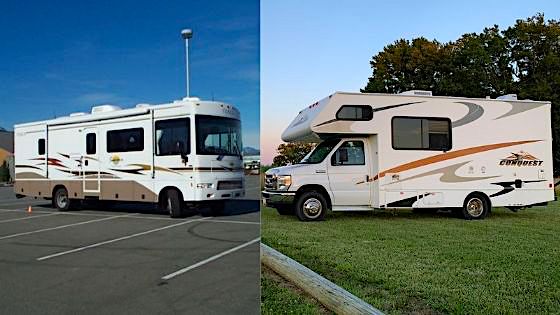Thanks for your support! If you make a purchase using our links in this article, we may make a commission. And, as an Amazon Associate, I earn from qualifying purchases. See the full disclosure here.
Updated April 27, 2024
Susan and I own a Class C RV but we are considering buying a Class A Motorhome. So, we looked at the pros and cons of Class A vs Class C Motorhomes and How to Choose Which is Best. The main factors we are taking into consideration are:
- Ability to Tow a Car
- Amenities
- Drivability
- Ability to Fit in Campgrounds and Campsites
But, there are many other factors to consider when comparing a Class A to a Class C RV and we cover 20 of them in this article. We are really torn between a Class A vs Class C. Our Class C RV is only 24′ long so it is very easy to maneuver. But we also have to use it as our only vehicle. It can’t tow more than 5,000 lbs so we would need to find a very light 4×4 vehicle if we want a toad.
If we move up to a Class A RV then we would have much more living space and we could tow a vehicle. But we would be very limited when trying to find campsites. We like as much privacy as possible when we camp and I feel that with a Class A RV, we will always end up in a row of pull-through sites in the middle of the campground.
We aren’t the only ones trying to compare and decide between a Class A or Class C and choosing the best RV or motorhome can be stressful. It’s important to make the right decision the first time so you don’t waste your money. Your motorhome is a big investment, therefore you want to make sure you buy exactly what you need and want.
- Is Buying A Used Motorhome A Bad Idea?
- Class A Motorhome Characteristics
- Class C Motorhome Characteristics
- Class A vs Class C RV Considerations
- 1. Length
- 2. Sleeping Arrangements
- 3. Price
- 4. Depreciation
- 5. Fuel Economy
- 6. Refueling
- 7. Slide Outs
- 8. Storage Space
- 9. Ease of Driving and Maneuverability
- 10. Driving in High Wind Conditions
- 11. Getting Around at Your Destination
- 12. Safety
- 13. Water Storage
- 14. Kitchens
- 15. Maintenance
- 16. Insurance
- 17. Amenities
- 18. Climate Control
- 19. Ability to Tow a Vehicle
- 20. Class A RVs vs Class C: Availability of Campgrounds and RV Parks
- Class A RV vs Class C – How To Decide Which is Best for You
- Where Can I Rent a Class A or C RV BEFORE I Buy One?
- Browse Class A and C Motorhome Rentals Near You!
- Final Words About Class A vs Class C RVs
- Related Reading:
- Mike Scarpignato – Bio
Is Buying A Used Motorhome A Bad Idea?
You’ve probably heard horror stories about someone buying a used motorhome and within the first season have major repair expenses.
While all used RVs regardless of type or manufacture are going to need repairs and maintenance, motorhomes are on a level of their own. Not only do you have all the RV-related repairs and maintenance that come with a travel trailer but you have a heavy-duty truck or bus powertrain and chassis to deal with as well.
Before buying any used RV it’s important to check maintenance records and have a good inspection done. When it comes to motorhomes this is critical. Having the drivetrain and chassis inspected by a mechanic could save you from getting into a real nightmare.
Class A Motorhome Characteristics
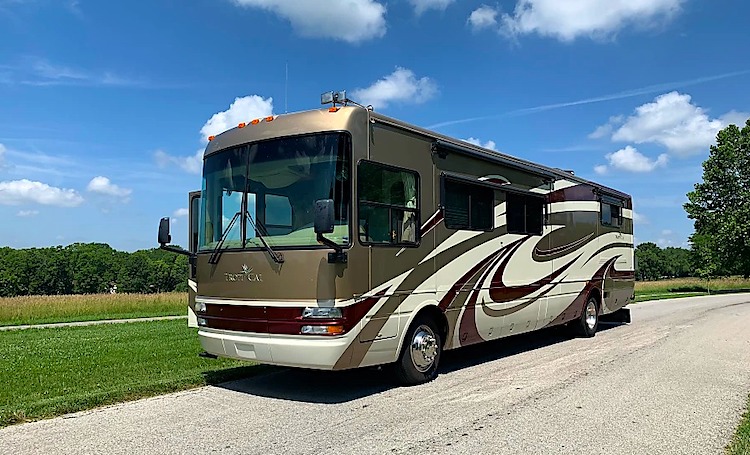
Sometimes referred to as the “King of Motorhomes” or bus-looking RVs, the Class A is the largest of its kind, and yes, it resembles a rock star’s tour bus. As a matter of fact, you will feel like royalty exploring the United States and Canada in a Class A motorhome because of its luxurious amenities.
This style of motorhome has almost every amenity your home has, including a washer and dryer, king-size bed, full-size fridge, outside entertainment center, and much more! Class A proves why RVs can be considered a home on wheels.
Class A Motorhomes do range in size from 21 feet to an amazing 45 feet long! Imagine all the people you could fit in a 45-foot RV. You can also choose a gas or a diesel model. The price for a Class A motorhome can range from $50,000 to $500,000 depending on the brand and options you choose. However, you can definitely find a used model that is much more affordable.
Class A Motorhomes can be for anyone who is looking to live a life of luxury on the road. Most commonly, Class A owners are full-time RVers, those with large families or retired couples looking to experience every inch of our beautiful country. A Class A would be most useful if you plan to use it year-round or quite a lot in general.
If you are worried about how to run a quick errand or explore outside of your campground, Class A motorhomes are also great for towing a small vehicle. No more worrying about taking down your campsite to leave. Just hop in your tow vehicle and adventure into the unknown.
The Pros of Class A Motorhomes
These RVs are not lacking in the department of luxurious amenities. They can sleep 6, 8, or even 10 people if needed. Many have separate master bedrooms with sofas and dining sets that convert to beds. Some models have bunk beds in addition to the master bedroom. The kitchens are larger and fully equipped along with larger bathrooms.
The Cons of Class A Motorhomes
Their large size can make them intimidating and therefore, difficult to drive for some. To purchase and operate Class A motorhomes can be expensive. For example, the fuel economy is very poor which can make it a budget buster.
They can also be difficult to fit into certain spots, especially at campgrounds. Class A motorhomes are like a house on wheels. Many new RV owners opt for a Class C or Class B to get their feet wet.
Class C Motorhome Characteristics
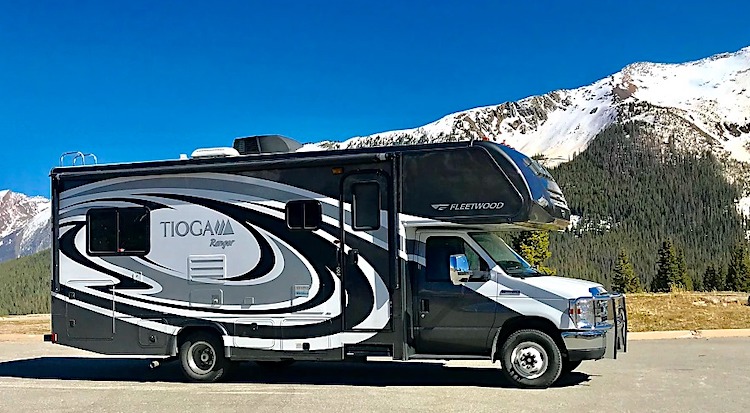
Class C motorhomes are becoming more popular in the RV world. They can hold more people, and they can be found at a more affordable price point. Class C Motorhomes are built on a truck or van chassis with an attached cab section.
Class C motorhomes feature many of the luxuries of your home, but they are easier to maneuver than Class A. They are also famous for their over-the-cab bunk perfect for families or full-timers who host guests.
Class C Motorhomes are somewhere between Class A and Class B. They are often built on a truck or van chassis that is specifically designed for a motorhome. They have an attached cab and most have an overhang that extends over the cab. This area is usually used as sleeping quarters but may also be used for storage.
The Pros of Class C Motorhomes
These motorhomes have similar amenities to Class A but typically have a much more budget-friendly price tag. They do get much better gas mileage than Class A motorhomes, which is a definite checkmark in the Pro column!
The Cons of Class C Motorhomes
The size is not as great for the Class C motorhome as say travel trailers, but they are definitely smaller than the Class A motorhomes. But they are still too large to fit in a garage. Thus, some won’t even fit in a driveway.
They are also limited when it comes to space. If you want a family vacation vehicle, this could be the one. If you are looking for something to full-time in, though, you may want to look at something a little larger.
Class A vs Class C RV Considerations
1. Length
Class A RVs and motorhomes are true behemoths of the road, they are usually built on a bus chassis, and it shows in their appearance. Size ranges from a humble 24 feet up to the 40-foot plus mega motorhomes.
Class C RVs, on the other hand, are far more compact. They are typically built on a heavy, or super-duty truck frame. They range in size from 21 feet at the lower end, to the largest you’re likely to find at about 35 feet although some manufacturers have built them as long as 40 feet!

2. Sleeping Arrangements
One of the most distinctive features of a Class C RV is the over-cab sleeping arrangement. The over-cab area provides extra sleeping or storage space without eating into the living area of the RV. Class C RVs also tend to be a little more dynamic in design, and feature converting tables and couches to provide additional berths in addition to the fixed beds and bunks.
The typical Class A RV features spacious, fixed sleeping arrangements, including a walk around queen, or even a king-sized bed. But it isn’t likely to have much in the way of convertible couches or dinettes because they are more likely to contain a more residential style of furniture.
3. Price
The cost of a new RV is where you’ll find some of the most extreme differences between Class A and Class Cs. Class C RVs are typically a little cheaper, and brand-new models tend to start at around $50,000 at the low end and can cost as much as $750,000 for the most luxurious styles.
Class A RVs come with a base price of about $15,000 more than your average Class C, starting at around $65,000. You should probably take a seat before we point out the cost of the world’s most expensive Class A rig. Ready? The most expensive factory-built RV ever sold went for a massive $3.1 million.
4. Depreciation
Depreciation is an unfortunate fact of life when it comes to RV ownership. It affects all styles, including travel trailers, fifth wheels, as well as Class A, B, and C motorhomes, especially when purchasing new. A Class A or Class C RV is a significant investment, and if you like to change your rig every few years, being aware of the effects of depreciation is important. Used RVs still depreciate, but at a slower rate than brand-new ones.
So, which style is the better investment? Well, a Class A will generally have a higher initial cost and is expected to lose approximately 43% of its MSRP over the first three years alone, and could lose a whopping 75% over ten years. On the other hand, a Class C RV loses an average of 26% of its initial value in the first three years of ownership, and over ten years this stretches to as much as 61%. In both cases, the value does drop noticeably, but as a long-term investment, the smart money buys a Class C rig.
5. Fuel Economy
For several reasons, a Class C RV is going to net you better overall fuel economy than a Class A model. First and foremost, the weight. Class A motorhomes are overall larger and heavier than an equivalent Class C, and all this extra weight means more power is required to get them moving. Gas mileage for a Class A is often as little as five to seven miles per gallon.
Another reason for the decreased fuel economy of Class As vs. Class C models is the shape. A Class A is hardly the most aerodynamic design; that big flat front acts like a sail at high speed and creates significant wind resistance. Class C units are a bit more streamlined and cut through the air with greater ease, achieving closer to eight to ten miles per gallon.
RELATED READING: Check out our article called What Is the Average Gas Mileage for a Class C RV? for some great info about Class C Gas mileage and also how to improve your gas mileage no matter what type of motorized or towable RV you drive.
6. Refueling
Road trips in an RV require planning, but driving a Class A will likely need even more planning. Smaller gas stations may not accommodate large Class A RVs. Therefore, you’ll have to keep the tank topped off whenever you see a full-service gas station equipped for semi-trucks.
All but the very largest Class C RVs should be able to fit in comfortably, and maneuver around almost any gas station you’ll find. Therefore, class C RVs may be a better choice for anyone who prefers to drive off the beaten path where you may not find a larger gas station.
7. Slide Outs

One advantage that Class A models have over their Class C counterparts is the size of the slide-outs. Class A RVs have larger slide-outs. Class Cs, also have slide-outs, but Class A units almost always feature at least one slide-out.
A slide-out will enable you to quickly and conveniently expand your living area when you arrive at your destination. Slide-outs aren’t only limited to living areas, though. They are often able to expand the footprint of kitchens, bedrooms, and bathrooms, too. Slide-outs do come with a catch though. Because you’re adding moving parts and electric motors, there is going to be an increased amount of maintenance to keep it all running smoothly. And of course, more components mean more potential points for failure.
8. Storage Space
Hands down, the Class A RV beats the Class C when it comes to storage space. The high-riding design of Class A RVs allows for plenty of basement storage space. There are many cubbies and pass-through storage spaces that doesn’t take up any living room inside.
Some Class A RVs even have enough basement storage space to fit ATVs, motorcycles, golf carts, and NEVS. Of course, these are some of the biggest and most expensive Class A Motorhomes. But if this volume of storage is something you need, then it’s good to know it’s available.
9. Ease of Driving and Maneuverability
Your overall experience with RVs is a significant factor when it comes to choosing what you’re comfortable with driving. Driving a Class C RV comes much more naturally to the average person, mostly thanks to the familiar truck-style cab layout. Pedals and controls are where you’d expect them to be, and the front wheels are way out in front of you, as you’d find in any car or pickup. The shorter wheelbase of a Class C also means they have a tighter turning radius. And while not exactly a sports car, you’ll have a much easier time maneuvering at low speeds than you would in Class A.
The first time I drove a Class A RV I was out of my element very uncomfortable. I was sitting much higher than usual and I wasn’t used to driving a rig that big. I actually thought that RV driving school might be a really good idea if I decided to buy a Class A RV. So of course, I looked into it and wrote an article about it.
RELATED READING: Check out our article called Is RV Driving School Worth the Money? It’s a really informative article about your options to save money while learning to drive and operate an RV or motorhome.
A class A RV is a whole other animal when it comes to driving. For starters, the pedals are offset to the right to make room for the steering column since the driver sits over top of the front wheels. Also, the increased height means you need to exercise even more caution when approaching bridges or low overhead hazards (for obvious reasons!). First-time RVers are definitely going to feel more comfortable behind the wheel of a Class C.
10. Driving in High Wind Conditions
One of the cardinal rules when driving any RV is if it gets too windy, pull over, no matter how tempted you are to continue your journey. But, some RVs are more capable than others when it comes to windy conditions. Class C RVs have a lower center of gravity than Class A rigs, and as a result, they’re better able to handle crosswinds without risking a dangerous tip-over situation.
RELATED READING: Check out our article called When is it Too Windy to Drive an RV? for more info about driving an RV in the wind.
11. Getting Around at Your Destination
We can talk about the features of Class As and Class Cs ’til the cows come home, but what about driving around town. You also need to consider where you will be driving. For example, it may be impractical, or impossible, to drive your rig into crowded areas with narrow streets. Since Class C RVs are generally smaller, they are easier to drive on smaller streets. We drive our 24′ Class C everywhere very easily.
You should probably check the rules for your planned stops since some national parks and private campgrounds have maximum RV size limits. And many Class A’s fall on the larger side of allowable size.
12. Safety
Modern RVs are inherently safe, but some factors make some RVs safer than others. Class C RVs boast more in the way of safety features than Class As, such as seatbelts, for example. Many Class Cs even feature seatbelts in the living area, unlike Class As which rarely carry this feature.
When it comes to frontal crash impact, Class Cs come out on top again. A Class A driver is seated incredibly close to the front glass, and models rarely feature airbags. Class C models boast the same airbag protection as the trucks they are based on, and also feature an increased impact-absorbing crumple zone.
13. Water Storage
If you’re planning on Boondocking or staying at a site that doesn’t have water or sewer hookups, a Class A might be a better choice. The increased storage space of this RV gives you plenty of space for larger fresh, gray, and black water tanks. Class C RVs by design have less space for fresh and wastewater. Therefore they are better suited for short-term stays or visits to locations with the necessary hookups.
14. Kitchens
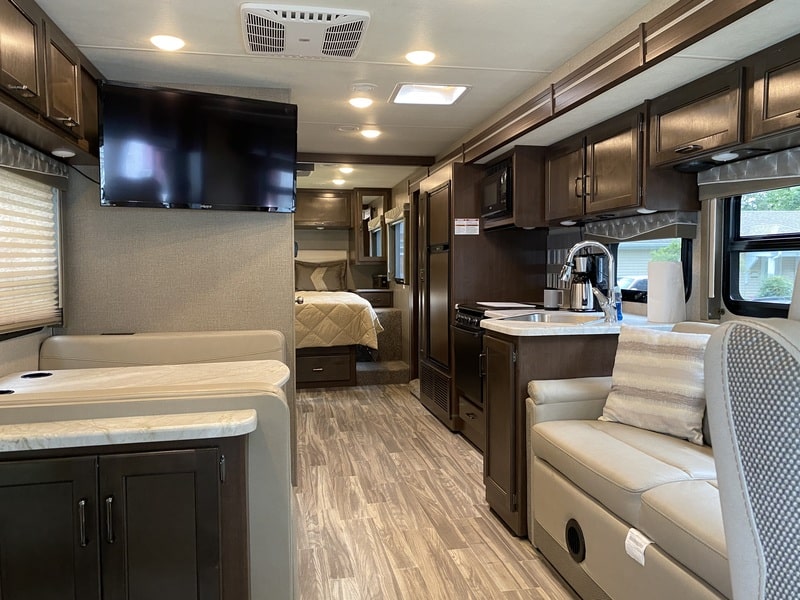
Those who love to cook are most likely to be swayed by the kitchens available in Class A RVs. While Class C RVs can have beautiful appliances, they really can’t compete with Class A. Some Class A RVs have gourmet kitchens that rival kitchens in luxury homes. They have full-size islands, residential-size sinks, residential fridges, and full-size gas cooktops. There is also more kitchen storage space, and this is something to bear in mind if you’re thinking of living in your RV full-time.
15. Maintenance
Sadly, the ‘maintenance-free’ RV has not been invented yet. So you should factor maintenance into your lifestyle and budget. Class Cs come into their own when it comes to maintenance, mainly because of their close relation to pickup trucks.
If you find yourself having issues in a small town, you’re far more likely to find a mechanic able to work on a Class C RV than you are one who can perform work on a more complicated Class A rig. Not only are you more likely to find a qualified service tech, but you’re also more likely to find parts. And this can make the difference between an enjoyable vacation and a ruined one.
16. Insurance
Insuring your RV is another necessary cost of ownership, and not all motorhomes are created equal when it comes to protecting them against loss or damage. You can expect that a Class A will typically cost more to insure than a similar size Class C. Some of the most important factors in the increased cost are for safety and maintenance.
Additionally, the increased perception of luxury with Class As makes them a bigger target for thieves than Class C, again a risk factor that insurers don’t like.
RELATED READING: For a very detailed analysis of RV insurance check out our article called How Much Does RV Insurance Cost?
17. Amenities
The sheer size of Class A RVs’ living areas means that they have room for facilities than Class C RVs. Class A engines are typically larger and can haul a more significant weight (some can weigh as much as 30,000 lb). In a Class A RV, you’re going to find full-size bathrooms with separate toilets, full-size washing machines and dryers, and much, much more. Class A RVs often boast luxury fixtures and fittings, too, and in some cases, this even extends to high-end granite countertops and tile flooring.
Class C RVs also have fantastic amenities and finishes. And, some of the Super C models on the market can rival any Class A motorhome.
18. Climate Control
The expansive glass windshield of a Class A motorhome is a perfect way to soak up the vistas on the way to your destination, but they also turn the cab into a greenhouse. All that glass traps the heat and forces your air conditioning to work overtime to keep the temperature down
With a Class C, the windshield being mostly the same as that in a truck, you’re not going to have quite the same issues in keeping your temperature down on hot days.
19. Ability to Tow a Vehicle
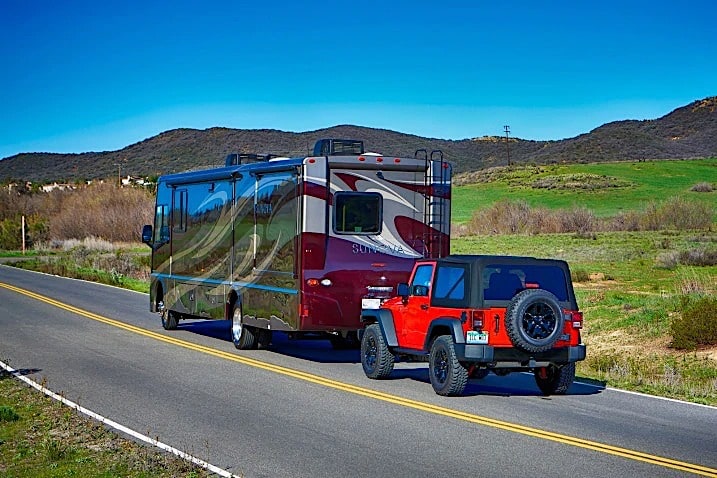
Many people who drive Class As have a toad or tow vehicle. They use it to drive around in so they don’t have to drive the RV once they’ve reached their destination. However, the addition of a tow vehicle will increase your maintenance requirements. And the toad will increase the overall length.
Some people also have a toad when traveling in a Class C RV. We are trying to find a nice light vehicle to tow behind our class C too. But we are very comfortable with traveling and sightseeing in our Class C. Unless you are looking at a 26-foot Class A, your best option, if you want to reduce driving complexity is a Class C but if you want a car to drive around once you reach your destination a Class A is definitely the way to go.
20. Class A RVs vs Class C: Availability of Campgrounds and RV Parks
It is far easier to find campgrounds for a class C RV because the class C is generally shorter and lighter than a class A RV. But there are some smaller class A RVs on the market but Class A RVs are typically heavier. So, if you want a campsite near a river or lake a Class A may be so heavy that it sinks into the ground. You might be surprised but it happens more often than you think. So, I think Class C RVs outweigh Class A RVs in this area. (Get how I switched that up!)
Class A RV vs Class C – How To Decide Which is Best for You
Susan and I feel that the best way to decide which RV Is Best for You is to rent one and try it out BEFORE buying one. We actually rented a Class C RV before we purchased our Class C and it was worth every penny. Finding the kind of bed and bathroom we liked was important. We also learned how much storage space we needed. We learned that a small Class C RV was very easy to drive and that we could fit in most campgrounds and campsites.
Since we own a Class C RV we plan to rent a Class A RV for a week or two and try it out before deciding if we want to move up to a Class A RV. We want to take some time to drive it and see what we like and don’t like about it so when we are ready to buy a Class A we can make the most informed decision possible.
If you own a travel trailer or 5th wheel and you are trying to decide between a Class A vs a Class C RV then I would recommend renting a Class A and a Class C before you decide on the Class A RV vs a Class C.
Where Can I Rent a Class A or C RV BEFORE I Buy One?
We recommend renting an RV through a company called Outdoorsy. Outdoorsy connects private RV owners with people like you and me who are looking to rent an RV for a weekend, a week or even longer. Outdoorsy is like a directory of RVs that are available near you with detailed listings and pictures. They handle all of the paperwork, deposits, insurance, and details of the rental transaction making it an easy process.
Susan and I recommend that you find an RV as close as possible to the one you might purchase. This way you can try one out BEFORE you buy it and make sure it suits your needs. It really is the best way to make an informed buying decision. And, you get some camping time to enjoy the RV while you see what you like, and don’t like about it. And, there is no better company than Outdoorsy for your RV Rental.
Browse Class A and C Motorhome Rentals Near You!
For more info about the types and styles of RVs check out these Helpful Blog Articles below:
Final Words About Class A vs Class C RVs
Buying a new or used motorhome is an exciting time that comes with a lot of tough decisions.
The first thing you’ll have to decide is if you want a Class A or a Class C. They are very different RVs so it’s gonna take some research and testing to see which is the right fit. Hopefully our breakdown of the two helps in your decision.
Related Reading:
–How Much Does a Class C RV Cost?
–What’s the Average Discount When Buying an RV Through Costco?
–Class C RV vs 5th Wheel – Which is Better and Why?
–Motorhome Leasing vs. Buying: Which Option is Best?
Are you trying to decide between a Class A vs Class C and have some comments or suggestions to share? Please leave your comments below. Maybe you can help us decide too!
Mike Scarpignato – Bio
Mike Scarpignato created RVBlogger.com over five years ago in 2018 to share all we have learned about RV camping.
Mike is an avid outdoorsman with decades of experience tent camping and traveling in his 2008 Gulf Stream Conquest Class C RV and 2021 Thor Challenger Class A motorhome.
We attend RV Shows and visit RV dealerships all across the country to tour and review drivable motorhomes and towable trailers to provide the best evaluations of these RVs in our blog articles and YouTube videos.
We are 3/4-time RVers who created RVBlogger.com to provide helpful information about all kinds of RVs and related products, gear, camping memberships, tips, hacks and advice.


